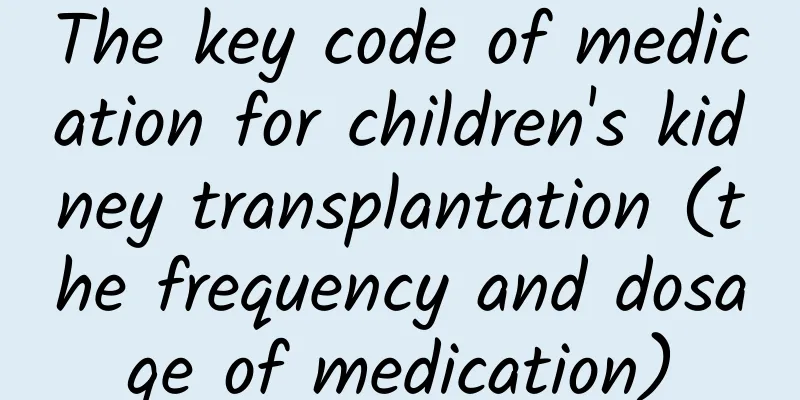The key code of medication for children's kidney transplantation (the frequency and dosage of medication)

|
Kidney transplantation is the best choice for treating end-stage renal disease in children, with 1-year and 5-year survival rates of 98% and 94% respectively. Compared with hemodialysis treatment, children who receive kidney transplantation not only have a higher survival rate, but also significantly improve their quality of life, and are also conducive to promoting catch-up growth in children. The following is an introduction to preoperative preparation, drug treatment, and complications of kidney transplantation in children. Preoperative examination of kidney transplantation in children Preoperative examinations for renal transplantation in children include laboratory tests, imaging examinations, urodynamic assessment, etc. 1. Laboratory examination: complete blood count, biochemical test, serum phosphorus and magnesium, parathyroid hormone, liver function, coagulation function, human leukocyte antigen and group reactive antibody, virus titer (cytomegalovirus, herpes simplex virus, varicella-zoster virus, Epstein-Barr virus, hepatitis B virus, hepatitis C virus, human immunodeficiency virus), etc. 2. Imaging examination: chest X-ray examination and abdominal ultrasound examination. In addition, voiding cystourethrography, cystoscopy and other examinations are also required depending on the condition. 3. Urodynamic evaluation: including bladder capacity, bladder pressure, urine flow rate and ultrasonic bladder residual urine volume measurement. If low bladder capacity, high storage pressure, incomplete emptying or high urination pressure are found in the urodynamic examination, intervention is required before kidney transplantation to prevent urinary tract infection, urinary tract obstruction or urinary incontinence. Drug therapy for renal transplantation in children Regulating the normal immune response mechanism is an important prerequisite for the success of organ transplantation. Therefore, it is necessary to reduce the immune response through drugs such as immunosuppressants. Currently, commonly used immunosuppressants include: corticosteroids, antimetabolites, calcineurin inhibitors and antibodies, and the commonly used one is a combination of tacrolimus, mycophenolate mofetil and prednisolone. Mechanism of action, medication recommendations and common adverse reactions of commonly used drugs for pediatric renal transplantation Complications of kidney transplantation in children Complications of kidney transplantation include surgical complications, urinary tract complications, postoperative infection, acute rejection, etc., as follows: 1. Surgical complications: cystic lymphangioma, wound infection, thrombosis, renal artery stenosis, etc. ●Cystic lymphangioma is the accumulation of lymph fluid around the kidneys, which usually manifests as graft fullness, pain, or decreased renal function. In severe cases, it can compress the pelvis and ureters, causing urinary tract obstruction and may also lead to venous obstruction. Ultrasound is the best examination method, and laparoscopic surgery is the preferred treatment method. ●Wound infection manifests as swelling, erythema, or purulent drainage from the incision, usually soon after kidney transplantation. Febrile patients with wound tenderness or swelling should undergo abdominal ultrasound or CT scan to detect the presence of perinephric effusion. If perinephric effusion occurs, surgical drainage should be performed immediately and antibiotics should be given. ●Thrombosis is one of the serious complications after kidney transplantation, with an incidence of 1% to 3%. It is mainly diagnosed by color Doppler ultrasound. Thrombosis may be caused by the recipient's hypercoagulable state. For patients who have experienced allogeneic transplant thrombosis, a thorough coagulation assessment should be performed before repeated transplantation. It should be noted that thrombosis needs to be diagnosed and treated in a timely manner, otherwise the consequences will be serious. Renal artery stenosis can be caused by anastomotic constriction, renal artery kinking, or segmental thickening of the renal artery intima or its branches, with an incidence of 1% to 5%. Digital subtraction angiography is the most sensitive diagnostic test. Treatment options include balloon angioplasty or open revascularization, of which balloon angioplasty has a higher success rate and a lower risk of complications. 2. Urinary tract system complications: including urinary tract obstruction and urine leakage. ●Urinary tract obstruction can be caused by surgical errors or distal ureteral ischemia, with an incidence of 2% to 4%. Ultrasound is the best method for diagnosing obstruction. Treatment options include balloon dilatation or ureterostomy. ●Urinary leakage manifests as incisional leakage, which is usually caused by rupture of the ureteral anastomosis to the bladder. Large and persistent leakage usually requires surgical repair. 3. Postoperative infection: Infection is one of the most important and common complications of kidney transplantation. It may occur at any time after transplantation, most commonly in the first 6 months after transplantation. The severity varies greatly and can significantly increase the mortality rate of children. Post-transplant infection can be caused by bacteria, viruses, fungi, mycobacteria and other microorganisms. ●Urinary tract infection is the most common post-transplant infection, with an incidence of up to 30%. Its treatment depends on the severity of the infection. Children with UTI and fever, nausea, myalgia, or other systemic symptoms should receive broad-spectrum parenteral antibiotics; children with UTI who are afebrile can be treated with oral antibiotics. Gram-negative bacilli are common bacteria that cause post-transplant urine infection; therefore, antibiotics that are sensitive to Gram-negative bacilli can be used for treatment before urine culture results are available. ●Viral infections include cytomegalovirus, Epstein-Barr virus, herpes simplex virus, varicella-zoster virus, and BK polyomavirus. Among them, cytomegalovirus infection rate is relatively high, and up to 90% of children will develop cytomegalovirus in the first 3 to 6 months after transplantation. 4. Acute rejection: including acute rejection and chronic allogeneic transplant nephropathy. With the application of more specific immunosuppressants, immune reactions after kidney transplantation are becoming less and less. However, rejection is still the most common cause of allogeneic kidney loss in children and adults. ●Acute rejection is an immune response to the allograft that can lead to a rapid decline in renal function, usually manifested by a rapid rise in serum creatinine without other signs or symptoms. Severe acute rejection may cause fever, myalgia, graft pain, or decreased urine output, and renal biopsy is the most reliable diagnostic test. Mild acute rejection can be treated with a short-term pulse of corticosteroids [5 mg/(kg·d) IV for 3 days, then tapered to baseline steroid dose over 7 to 10 days]. Acute rejection that does not respond to steroid pulse therapy and severe acute rejection can be treated with antilymphocyte antibodies. ●Chronic allograft nephropathy is defined as an immune response to the allograft that leads to a gradual and sustained decline in renal function, usually manifested as a gradual increase in serum creatinine. Patients are asymptomatic and require a renal biopsy for diagnosis. There is currently no effective treatment for chronic allograft nephropathy, and preventing acute rejection is the best way to avoid its occurrence. References: [1] Verghese PS. Pediatric kidney transplantation: a historical review. Pediatr Res. 2017 Jan;81(1-2):259-264. doi: 10.1038/pr.2016.207. Epub 2016 Oct 12. PMID: 27732587. |
>>: Master these kidney health tips to make your kidneys healthier
Recommend
What causes palace erosion?
There are many kinds of gynecological diseases, a...
What causes itchy pubic skin?
Pubic hair skin itching is a common gynecological...
What to eat during the confinement period to restore the uterus
During abnormal childbirth or abortion, the femal...
Can mothers eat garlic during confinement?
Garlic is also called Hu garlic or garlic in many...
There are lumps in the chest during confinement
During the confinement period, women not only nee...
When is the best time to eat pet nutritional paste? How to choose dog nutritional paste without making mistakes
Nutritional paste is a common pet food in life. I...
N questions about the most private part of a woman's lower body
The vulva is the most private part of women and i...
Can pregnant women eat honey bayberry?
Bayberry wine is known as the "agate stone a...
What are the foods that can nourish the kidneys for women? Women should also eat the right food to nourish their kidneys
It is very important for women to protect their o...
What should I say to my children before the college entrance examination? What should I eat before the college entrance examination?
The college entrance examination season is coming...
What to do if your menstrual period is delayed
Women's bodies need comprehensive protection,...
What are the benefits of eating pistachios for women? Is it better to eat pistachios raw or cooked?
The skin of pistachios contains a lot of anthocya...
A man vomited blood and fainted after eating too much bamboo shoots! Don’t let bamboo shoots turn into “spring damage”, you must pay attention to these 3 points
Recently, the news that "a man vomited blood...
Is there any connection between periodontitis and bad breath?
Bad breath has always been a health problem that ...
Can scalding tableware before meals be used to disinfect it? What can children use to disinfect their tableware?
When we go to a restaurant to eat, we will use te...









